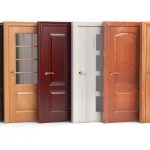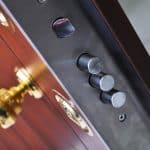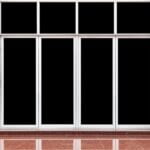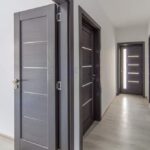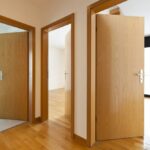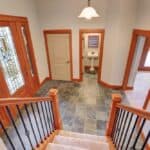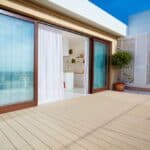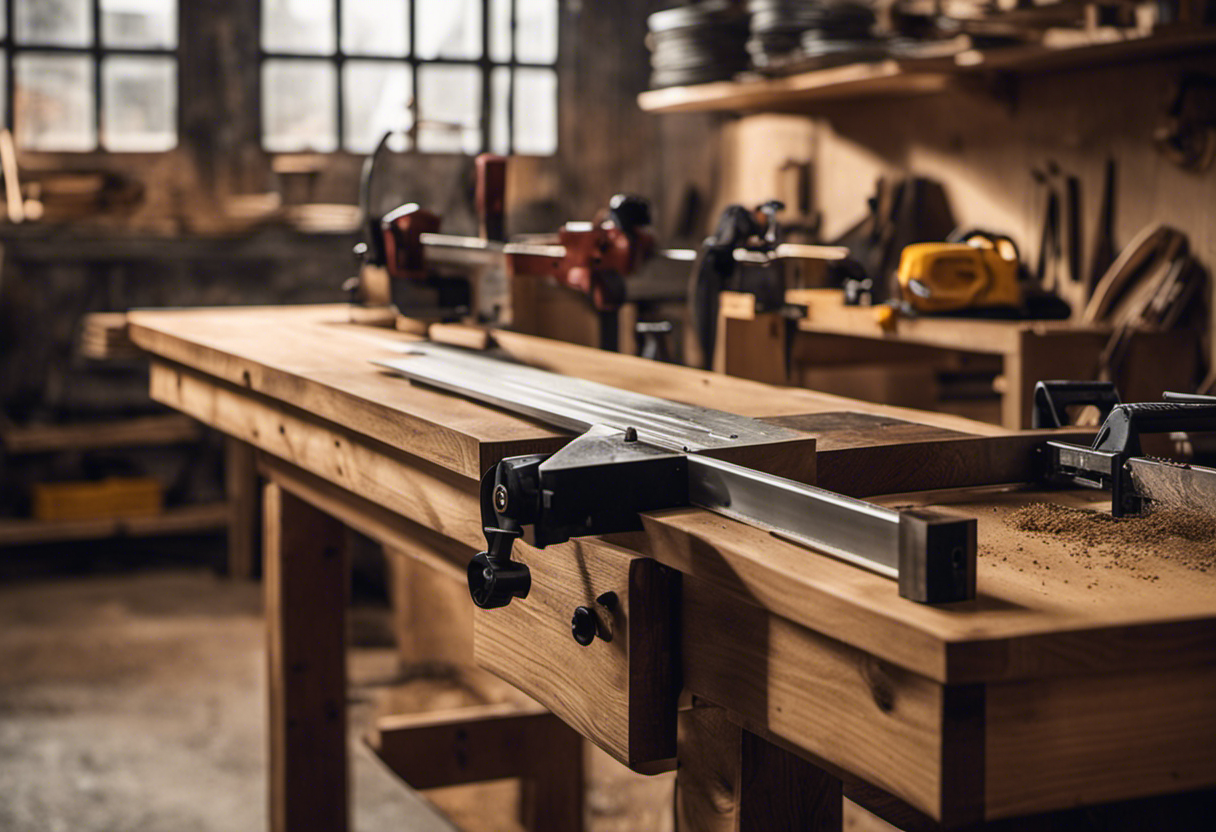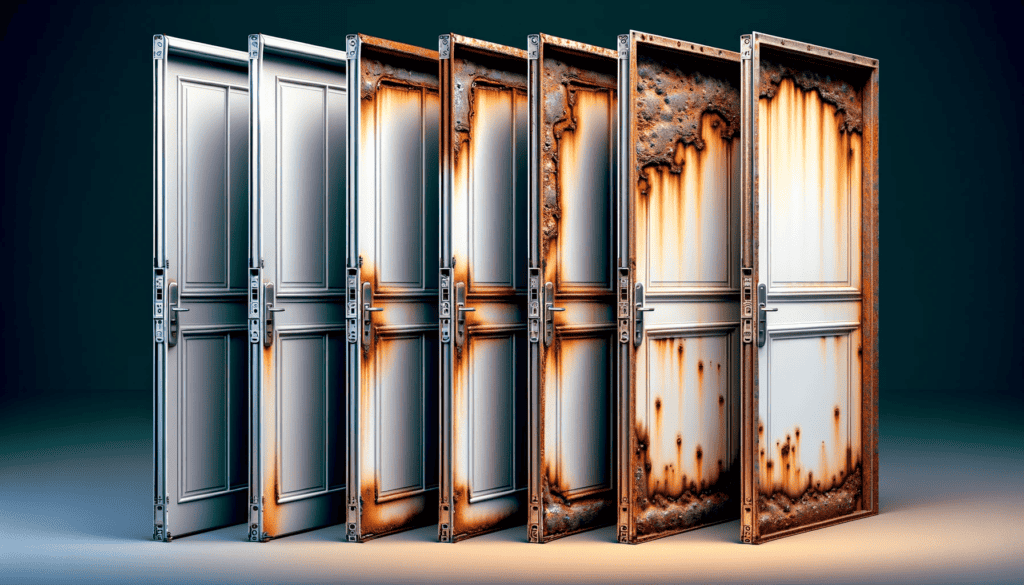
Rust formation is a prime concern for any steel product exposed to the elements. As a naturally corrosive metal, steel reacts when it comes into contact with oxygen and moisture, leading to oxidation and the development of the distinctive reddish-brown rust. Rust resistance is highly desirable for items like doors acting as your home’s first line of defence.
This guide takes an in-depth look at the susceptibility of steel doors to rust and provides actionable advice on preventative care and maintenance best practices. With the proper precautions, steel doors can retain their strength, durability, and aesthetic appeal over the years.
Key Takeaways on Steel Doors and Rust
Before diving into the nitty-gritty details, here are the key facts and statistics to remember:
- Prone to Rust: As a ferrous metal, regular carbon steel naturally erodes and forms rust when exposed to oxygen and moisture. This can compromise the door’s integrity over time.
- Galvanized Steel: Doors made of galvanized steel are dipped in a protective zinc coating, making them far more rust-resistant. The zinc acts as a barrier against corrosion.
- Powder-Coated Steel: Powder coating gives the steel an even stricter barrier, helping resist scratching, fading, and rust formation. It provides excellent protection in coastal areas.
- Regular Maintenance: While certain steel types resist rust, no door is immune. Routine inspection and wiping down are key to preventing corrosion and deterioration.
What Causes Rust to Develop on Steel Doors?
When used indoors, Steel’s Achilles’ heel tends to oxidize when exposed to the environment. Here are the main culprits that lead to rust formation:
- Oxygen: When oxygen molecules come into contact with bare steel, they naturally begin corroding the surface metal atoms. This effect is exacerbated by moisture.
- Water and Moisture: Water provides the electrolytes for the chemical reaction between the steel’s oxygen and metal iron atoms. The result is rust formation.
- Carbon Dioxide and Pollutants: Industrial emissions in the air can accelerate the corrosion process in what’s known as atmospheric corrosion.
- Temperature Fluctuations: Changes between cold and hot weather cause condensation buildup, introducing moisture that leads to rust.
- Scratches and Imperfections: Small scratches in the steel finish expose the bare metal and allow rust to take hold. Imperfections act as crack points.
- Time: Given enough time, regular carbon steel will eventually exhibit signs of rust without proper maintenance.
Comparing the Rust Resistance of Different Steel Types

Not all steel is made the same. The type of steel used in door construction impacts its susceptibility to rust. Here’s how they compare:
- Regular Carbon Steel: Has minimal inherent rust protection. Requires added coatings for corrosion resistance when used indoors.
- Stainless Steel: Alloys like 304 and 316 stainless steel contain chromium that forms an oxidation layer protecting against rust. It’s more expensive than regular steel.
- Galvanized Steel: This steel is dipped in a zinc coating that protects the underlying steel from rusting. More corrosion resistant.
- Weathering Steel: Alloys like COR-TEN develop a rust-like patina finish protecting the actual steel below. Has an attractive, aged look.
When selecting a steel door, galvanized and stainless steel offer the best resistance against rust formation. The zinc in galvanized steel acts as a sacrificial anode, while stainless alloys contain anti-corrosive chromium.
How Different Environments Affect Rust Formation
Where the steel door is installed impacts how quickly rust develops:
- Coastal Regions: The salt air and moisture in coastal areas speed up rust formation on steel doors. Frequent maintenance is a must.
- Industrial Areas: Higher concentrations of carbon dioxide, sulphur dioxide, and other pollutants in the air in urban industrial zones will corrode steel faster.
- Swimming Pools: The chlorinated, humid environment around pools requires vigilance against rust. Stainless steel doors are preferred here.
- Dry Climates: Low humidity limits rust formation, but temperature fluctuations between night and day can create enough moisture through condensation to corrode steel.
- Tropical Wet Climates: Abundant rainfall and persistent humidity accelerate the corrosion of steel doors here. Galvanized or powder-coated options are preferred.
Generally, steel doors installed in drier regions like deserts will have slower rust formation than in tropical or coastal areas. However, no location is fully exempt from potential corrosion over the long run.
Preventing Rust on Steel Doors With Protective Coatings
The key to preventing premature rusting of steel doors lies in protective coatings that act as a barrier against moisture and oxygen:
- Zinc Coatings: Galvanized steel doors have a zinc coating bonded to the steel that shields against rust. Zinc sacrificially corrodes before the underlying steel.
- Powder Coating: A tough polymer powder coating provides excellent corrosion resistance while resisting scratching, fading, and impacts. It’s more durable than paint.
- Oil-Based Paint: High-quality oil-based paints create a protective coating that repels water and prevents rust. Requires more frequent repainting than powder coating.
- Stainless Steel Finish: While expensive, stainless steel doors require no additional coating, though the brushed finish can wear and expose metal over time.
When selecting a steel door, prioritize ones with intact galvanized zinc or powder coatings, which provide the most complete shield against rust formation.
Regular Maintenance Prevents Rust and Adds Years of Life

While high-quality steel doors will resist rust for years, periodic maintenance is required to keep corrosion at bay:
- Inspect Annually: Check doors yearly for rust spots, scratches exposing metal, and coating deterioration. Address problem areas immediately.
- Wipe Down Monthly: Wipe the door monthly with a microfiber cloth, warm water, and mild detergent to remove salt, dirt, and other corrosive buildup. Avoid abrasive cleaners.
- Touch-Up Paint: Spot any scratches, chips, or exposed steel using an oil-based touch-up paint matching the door’s original protective coating.
- Reapply Protective Coatings: Every 2-3 years, sand down the door and reapply a fresh round of protective paint or powder coating to renew the corrosion-resistant barrier.
- Check and Replace Weatherstripping: Defective weatherstripping allows outside moisture and pollutants inside to speed up rust formation. Replace worn strips.
With vigilant preventative care, a steel door can go decades without significant rust damage, even in harsh coastal environments. However, neglect leads to premature failure.
Proper Installation Techniques Prevent Early Rust Failure
How the door is installed impacts its long-term durability:
- Ensure the door’s protective coatings are fully intact before installation. Reject any with significant mars or scratches.
- Check that the frame opening is sealed correctly and vapour barriers are installed to block moisture ingress.
- Use non-metallic shims when plumbing the door to prevent galvanic corrosion between dissimilar metals.
- Caulk around the frame exterior with a quality exterior sealant to prevent water entry.
- Install proper flashing above the door to direct rain runoff from the frame and door.
- Hang the door with non-metallic hangers if possible to reduce potential galvanic corrosion.
- Ensure exterior trim pieces completely seal the gap between the door and frame.
The door will have excellent long-term corrosion resistance by reducing moisture exposure during installation.
Cost Analysis of Steel Door Types
Upgrading to more rust-resistant steel doors costs slightly more but adds value:
- Low-end hollow steel doors – $75-$150
- Medium-grade flush steel doors – $150-$300
- High-end galvanized steel doors – $300-$700
- Prefinished galvanized steel doors – $500-$1,000
- Stainless steel doors – $1,500-$3,000
- Custom exotic steel doors – $3,000+
Generally, galvanized and prefinished steel doors provide the best return, balancing affordability with excellent rust resistance. Stainless steel is overkill for most single-family homes. Prioritize thickness and insulating cores as well to boost energy efficiency.
How Steel Doors Compare to Other Materials
Steel doors have pros and cons compared to wood and fibreglass:
Strength and Security
- Steel doors are more challenging to force open, offering increased security over wood or fibreglass. The metal’s strength deters break-ins.
Fire Resistance
- Steel doors intrinsically provide more fire resistance than wood and most fibreglass units. This enhances safety in a fire emergency.
Environmental Impact
- Steel doors have less ecological impact as recyclable than resource-intensive fibreglass doors. Only sustainably sourced wood doors compare.
Appearance
- Steel doors offer less aesthetic variety than wood, but factory finishes, decorative glass, and carving can add curb appeal. Fiberglass has greater design flexibility.
Longevity
- With proper maintenance, steel doors outlast wood doors exposed to the elements. But fibreglass doors may have a slight longevity advantage with no risk of rust.
Steel comes ahead of most other options for the optimal balance of security, fire resistance, sustainability, and longevity in harsh climates. Maintaining the finish is key for ongoing performance.
The Latest Innovations and Trends for Steel Doors
Ongoing innovations in steel door manufacturing and design are enhancing aesthetics and functionality:
- Textured Finishes: New texturing processes like wood grain, sand, and metal patterns provide designer looks without paint. Enlarges decor options beyond smooth steel.
- Custom Carving: CNC precision carving machines allow for one-of-a-kind carved designs in steel for decorative flair.
- Mixed Material Doors: Combining steel with iron, wood, or glass inlays creates unique blended designs marrying industrial and natural elements.
- Smart Technology Integration: Some newer steel doors integrate smart locks, touchscreens, cameras, and sensors for next-level access control and security monitoring.
- Improved Weatherproofing: Advanced framing, triple weatherstripping, and proprietary insulation provide excellent thermal performance that further resists moisture intrusion.
With powder coating and galvanizing now industry standards, the new frontier for steel doors enhances aesthetics and functionality while maintaining the core benefits of strength and corrosion resistance buyers expect.
Specialty Coatings and Treatments That Deter Rust
Beyond galvanization and powder coating, specialty coatings and treatments can further bolster steel’s rust protection:
Thermal Diffusion Galvanizing
- An advanced hot-dip process that deposits more zinc than typical galvanizing for enhanced corrosion resistance. Ideal for coastal regions.
Epoxy Primers
- Industrial-grade epoxy primers chemically bond to steel for a moisture-proof undercoat that prevents rust from forming. Must be reapplied over time.
Rust Converter
- Converts existing rust into an inert protective coating. It stops rust from worsening but doesn’t prevent new corrosion.
Ceramic Nanocoating
- Applied as a liquid, ceramic nanocoatings cure into an ultra-thin glass film, repelling water and stains. Highly scratch-resistant.
Laser Cladding
- A high-tech process where corrosion-resistant alloys are fused to the steel’s molecular structure with a concentrated laser for permanent rust-proofing.
While cost-prohibitive for most homes, these commercial and industrial-grade solutions demonstrate the ongoing advances in achieving truly rust-free steel doors.
Handy Tips for Homeowners Dealing with Steel Door Rust
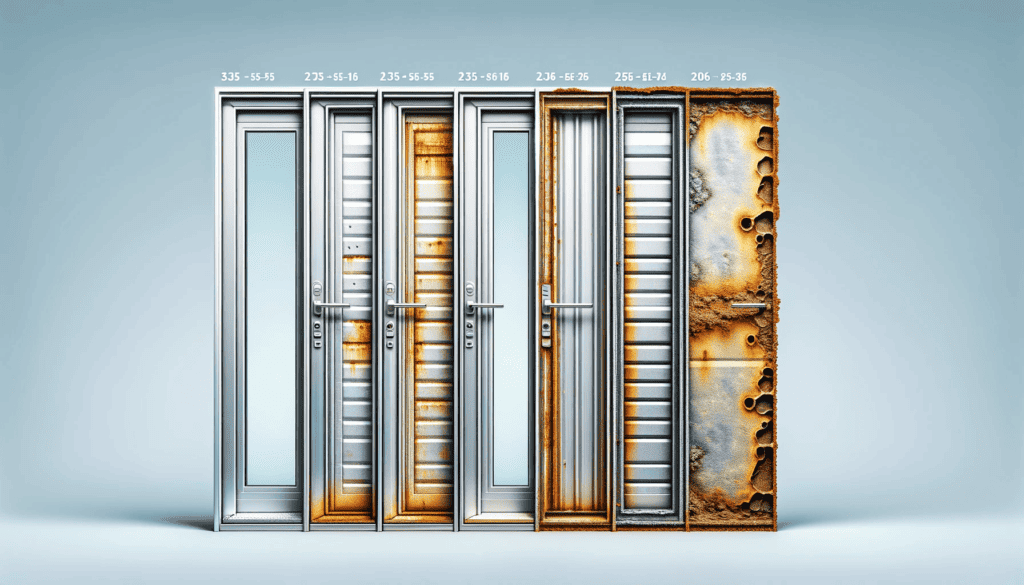
For homeowners stuck dealing with existing steel door rust, here are some budget-friendly solutions:
Light Rust
- For minor surface rust, scrub with a wire brush or sandpaper to remove corrosion, wipe clean, and apply touch-up paint to protect the steel beneath.
Moderate Rust
- Use a rotary wire wheel on a drill to thoroughly scour more substantial rust to bare metal. Wipe clean, dry thoroughly, and repaint with zinc-fortified rust-resistant enamel spray paint.
Severe Rust
- Extensive bubbling rust that has broken through the paint can’t be repaired – the door will need replacement. Sanding away this level of corrosion damages the underlying steel.
Limiting Rust Spread
- To stop rust from spreading across the remainder of the intact door, scour the surrounding area to bare metal and repaint. This isolates the corroded section.
With light preventative care, minor rust can be stopped in its tracks. But once severe rust takes hold, replacement becomes the only option. Don’t delay minor repairs.
Frequently Asked Questions
What are the best practices for preventing rust on steel doors?
Use galvanized or powder-coated steel doors, perform regular wipe downs, promptly fix scratches in the paint or coating, reapply protective coatings every 2-3 years, install the door to prevent water exposure, and repair weatherstripping when worn.
How often should steel doors be inspected for rust?
Inspect for signs of rust at least once yearly, ideally in the fall. This gives time to address issues before the height of the wet winter weather. Monthly wipe-downs also help spot early rust.
Can rusted steel doors be repaired, or must they be replaced?
Light surface rust can be cleaned, primed, and painted to stop spread. However, the extensive bubbling rust that has broken through the paint requires complete door replacement as the steel becomes damaged.
What makes galvanized steel doors resistant to rust?
Galvanized steel has a zinc coating bonded to its surface that acts as a sacrificial anode, corroding before the actual steel. This provides an extra protective barrier that steel alone lacks.
Are powder-coated steel doors more effective in preventing rust than painted doors?
Yes. The thick polymer resin powder coating cures into a formidable barrier that resists scratching, impacts, UV damage, and corrosion far better than conventional paints. Powder coatings last for decades.
Are Steel Doors Less Prone to Rust Than Hollow Core Doors?
Steel doors are indeed less prone to rust than hollow core doors. This is one of the benefits of hollow core doors. The steel material provides better protection against moisture and humidity, making them a more durable option for exterior doors, especially in areas with harsher climates.
Final Verdict: The Lasting Durability of Steel Doors Against Rust
Regular carbon steel’s natural tendency to rust means steel doors require preventative care and maintenance to maximize lifespan and preserve their good looks in outdoor applications. But galvanized and powder-coated steel doors, properly installed and cared for, can provide many years of near rust-free performance.
With some vigilance, you can expect a steel door to last at least 20-25 years, even in humid and coastal environments where rust thrives. Combine regular inspections, prompt repairs, and preventative coatings, and a steel door will grace your home’s entrance with strength, security, and rust-free beauty for decades to come.

I’m James Davis, a carpenter with eight years of experience in carpentry services, repairs, installations, renovations, and maintenance of interior doors. I have a diploma in carpentry and joiner trade from the Education Skills Australia Institute and take pride in delivering high-quality results to ensure customer satisfaction. I’m a blog writer for Octopus Doors Company and enjoy sharing my knowledge and tips on maintaining security measures and choosing the right door materials, paints, or handle styles. I specialize in custom-made interior doors and strive to make every home look fabulous. Contact me anytime for help with door-related issues.

